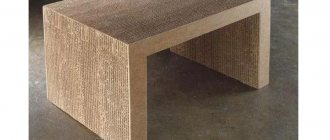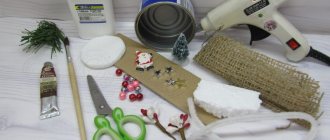In this review, the author shows how you can make a cubic water tank from a polyethylene sleeve with your own hands. Such a tank is useful in the countryside - the water can be used for irrigation.
To make such a tank, you will need a piece of plastic film 1.5 meters long. Moreover, it is advisable to buy the film as thick as possible, since thin films are often found defective.
First of all, using a hand drill, you need to drill holes in the ground for posts 50-60 cm deep. Both metal pipes and wooden posts can be used as posts (if, for example, you need to reduce the cost of the project).
1
How to make a water container for the country house
Do-it-yourself water container for a dacha - manufacturing In a country dacha, in a large number of cases there is no constant water supply.
In order to always have a water supply at your dacha, you will need a container of the required volume. You can buy it in specialized stores, or do it yourself. By the way, it is in the second case that you can save a lot. Such a design is not a whim, but a necessity, because water can only pump according to a schedule or even be completely absent. Unfortunately, in dry weather, plants may not wait until watering begins. It is actually painful to watch fruits and vegetables, as well as flowers, die under the scorching rays of the sun.
The only option for saving them would be a do-it-yourself water container for the dacha as an additional source of water.
Peculiarities
A tank for a summer house or garden plot must necessarily be more capacious than for city life.
Interruptions in the water supply (where there is one at all) happen much more often, and you don’t really have to rely on supplies.
In addition, the needs of summer residents and gardeners are very great. They need water for irrigation, for caring for garden houses, and for a number of other needs. Therefore , a capacity of 100 liters is only the initial level; sometimes it is advisable to buy powerful versions up to 1000 liters inclusive.
Types of containers
By the way, containers for storing water can be purchased at specialized retail establishments. In this case, you will be able to quickly solve the problem without making any physical efforts. But in this case you will need to incur financial expenses. If you don’t want to throw away the money you’ve earned, but there is a need for additional water supplies, then you can make a container for collecting and storing water yourself.
Homemade containers, as a rule, are made on the basis of suitable materials, which will be:
Each of these options will involve the use of appropriate tools, as well as performing actions exactly according to the instructions. Water containers can also vary greatly depending on the purpose. If water is required to water the garden, the reservoir must have a sufficiently large volume. Owners of dacha-type plots often try to make an outdoor shower. Water is also important for its normal functioning. The reservoir for collecting water mass can be small or medium-sized, depending on the family members who will plan to take the water procedure every day. In some cases, the purpose of purchasing or constructing an additional water tank will be to provide a supply of water for drinking. Additional requirements can be put forward for such containers, since it is important to maintain the cleanliness and potable properties of the water.
Which form is better?
The shape of the container for storing water at the dacha determines the ease of its installation and the tank’s ability to withstand certain loads.
It is advisable to install rectangular containers and tanks indoors, since they will fit exactly into any free corner, which cannot be achieved when using a round tank or barrel.
Round water containers in the country differ from rectangular tanks in that with the same wall thickness, due to a more uniform load distribution, they can withstand pressure better. It is better to place round barrels for collecting and storing rain and process water in an open space.
Containers of the Eurocube type have proven themselves well. Such containers are available in different capacities and can be installed both outdoors, for watering plants, and in the house, for storing drinking supplies. Thanks to the tap at the bottom of the container, you can make an autonomous watering system from the Eurocube, the water from which will flow into the ground under slight pressure. Another advantage that cubes have is their collapsible design. Collapsible rectangular cubes with a tap and lid are easy to move from place to place, and the pallet allows you to conveniently install them on the ground anywhere in the garden.
Review and details
Metal containers
Structures made of metal are often used to store masses of water. To create them, different metals are used depending on the purpose for which water collection is planned. If it is important to keep drinking water in reserve, high-quality stainless steel is selected for the manufacture of a metal tank. Even from this capacity, new demands are put forward:
This design allows you to maintain the quality of drinking water. Twice a year, such a tank must be cleaned, and it can be used with disinfectants. To facilitate the process of washing a metal barrel, a hatch of sufficient diameter is installed on the side. Such a hatch will be equipped with seals in order to ensure a normal degree of tightness. Owners of dacha-type plots are still striving to purchase or even make metal tanks in order to store water, which they plan to use in the future for technical needs:
In such cases, I take any metals as a basis. By the way, most summer residents install metal barrels specifically to collect water after rain. This solution will significantly save on water consumption. There is also an excellent opportunity to buy any barrels, even those that were previously used. It is important that toxic chemicals are not stored in them until such time.
Plastic containers
Plastic containers, as well as barrels, are increasingly popular because:
Do-it-yourself water containers can be made of plastic, and food-grade plastic will have additional advantages:
Due to these features, the water in such containers does not spoil for a long time. Most food-grade plastic barrels will have holes, and their diameter makes it possible to install taps in them. Plastic barrels can be horizontal or vertical. Eurocubes, which are placed in a metal type sheathing for an additional degree of strength and stability, are even more popular.
How to make containers from tires with your own hands
If you can’t buy water containers for a small amount, but you don’t want to spend a lot of money, you can make the design yourself. The storage tank can be made from scrap materials that are available on the farm or they can be borrowed free of charge from friends/neighbors. For example, you can even use old tires. It is advisable that these be tractor tires, as they have a huge diameter. Initially, you should determine the place where the structure will be installed in the future. This space should be leveled, and after that you can begin to create the main structure, following the step-by-step instructions:
Tips for choosing a polyethylene storage tank
For the manufacture of tanks, durable synthetic material is used - plastic, which ensures long-term operation of the products.
If its quality and product manufacturing technology do not meet existing standards, then the container will last half the guaranteed period or, with minor physical impact, will immediately become unusable.
Therefore, when buying a plastic tank, you need to take into account tips that will help you purchase a truly high-quality product.
Tip No. 1 - certificate of conformity
When purchasing a water storage tank, it is important to obtain a quality certificate for the product. Since the information in the document indicates that the product is made from certified raw materials using working equipment.
A bona fide manufacturer of containers, along with a technical passport containing performance properties, provides a certificate of conformity for the product
Obtaining a certificate of conformity is important when purchasing a drinking water tank. If the bowl was made of plastic grades 03-07, under certain conditions it releases life-threatening substances. Therefore, before paying, you must make sure that the container was cast from primary food grade polymer 01 and 02.
If this document is available, it is easier for the consumer to return the product to the seller if there are complaints about the quality.
Tip #2 – appearance
When examining the water tank externally, you need to make sure that there are no uneven walls. To do this, you should pay special attention to the convex parts of the container, and if in any area the plastic has a lighter shade or bends under finger pressure, then it is better to refuse to purchase this product.
Internal and external grooves, transitions from the neck of the tank, stiffeners and legs to the walls of the vessel must be smooth and neat
In addition, it is important to ensure the quality of the seams, or rather, their absence. High-quality connections are almost invisible, as they are made using seamless welding. Additional seams are excluded on a certified product.
The connection points of additional elements: bends, flanges, drains, handles, etc., must be thoroughly sanded.
Tip No. 3 – convenient transportation
If you plan to transport water to your summer cottage, you should consider plastic tanks equipped with special grooves.
By means of one or several recesses in the base, the container is tied and secured in the trunk or car body.
Internal and external recesses allow the tank to be secured to the vehicle. Through grooves, the containers are attached to the holding structure underground
How to weld a metal water tank on your site
Most people living in apartment buildings have a very vague understanding of the problems and concerns of private home owners. For example, the independent process of manufacturing a water storage tank from steel can become a reason for an ironic smile from an apartment resident. Although in fact, the possibility of welding a steel water tank with your own hands is an interesting and relevant question for many.
So, which approach should you choose, weld the tank yourself or order a ready-to-use tank?
Of course, you have the opportunity to seek the help of professionals. Prepare a competent drawing of the structure for them, and the water tank will be made in accordance with your wishes. If you don’t want to spend time drawing up a drawing, you will most likely be offered several types of designs to choose from. This is all great, but you will have to pay accordingly for quality work. In this regard, many homeowners opt for the second option - making the tank themselves. It's not very easy, but the real savings and moral satisfaction are worth it.
Application options
Storage tanks are relevant in places where there are interruptions in water supply. Indoors, water tanks are most often installed in a horizontal position.
The tanks are used to store rainwater and tap water. With their help, you can organize an outdoor shower or keep them for fire safety purposes so that you can extinguish the fire.
They can store water for watering plants, gardens and vegetable gardens. Often round tanks are installed in a bathhouse to store water. There are many designs that can be round, rectangular or other shapes.
It is important to understand what the tank is for. If it is used inactively, the water in it promotes the growth of algae and microorganisms
Moreover, if the container is constantly located in an open area under the sun's rays.
Therefore, choosing the volume of the tank is one of the main tasks before starting its manufacture. Ferrous metal tanks must be primed and painted to prevent them from rusting.
Step-by-step instructions for building a water storage tank
How are storage tanks used?
There are several common types of storage tank designs, most often they are rectangular or round.
Another important point: if we are dealing with a tank made of ferrous metal, then we cannot do without painting and priming, otherwise the structure will inevitably and quickly rust.
About the stages of welding
When welding, you should always make sure that none of the sides goes beyond the boundary of the base. You can apply the following approach: all the sidewalls are welded together and only then with the base. The fit of the sheets to each other should be as tight as possible.
At the next stage, we finally weld each seam. Welding can be done both from the outside and the inside. It is important not to leave a single “lack of cooking”. The structure must be rigid. To give it additional rigidity, we recommend using angles from the inside and outside.
An important design element is a drain pipe coupled with a tap, which must be installed in the lower half of the container.
Don't forget to check the tank's seal level!
We do the check like this. After completing the welding work, prepare the required amount of chalk solution and apply the mixture to each seam from the inside. After the solution has dried inside the container, apply the mixture to the seams outside. Thus, we will be able to identify “lack of penetration” clogged with slag. To do this you will have to wait a few minutes. If characteristic spots appear, it is necessary to deal with the problem area and repeat the welding.
Leak testing and re-welding are carried out immediately before painting.
The finished structure can be placed on several pre-laid bricks, but it is better to use the option with a special stand.
Finally, we fill the tank with water and, for several days, observe the walls of the structure for the appearance of liquid (from the outside).
Location of water tanks
The location of the tank determines the type of plumbing and equipment required for reliable and uninterrupted operation of the off-grid system.
A modern storage tank for water supply to a home and bathhouse has two installation options - upper and lower positions.
Upper
Such a scheme involves installing a storage tank at the maximum permissible height - a terrace, second floor, attic, on the roof or under the ceiling. The height of the location is proportional to the pressure force - for every 10 meters 1 bar of pressure is added.
When operating the hydraulic accumulator in winter, the device is additionally insulated.
The top location ensures better water intake even without the use of a pumping station, as well as simple and safe operation of the tank.
Lower
This method of installing a storage tank provides for the rational use of free space. In this case, a pump or pumping station is required to supply water to the house or bathhouse.
When placed at the bottom, water is pumped into the storage tank using a pump, resulting in the formation of a special air gap. When a certain level of water in the tank is reached, the air with maximum force pushes it to the intake points.
Often, to achieve optimal pressure when supplying water, a submersible drainage pump with a float installed inside the tank is used.
If a bottom-mounted water tank is planned to be used in winter, then it must be buried in the soil to a depth below its freezing level.
Additionally, reliable insulation is provided. When installing a summer water supply system, the storage tank can be located to a depth of up to 45 cm from the top soil level.
Important! For underground installation, the tank should be installed with a slight slope of up to 16 degrees. This will ensure one-sided accumulation of sediment under the cover.
How to weld a metal water tank yourself?
Reading time: 6 minutes
Anyone who has a dacha or country house sooner or later faces problems with convenient water supply. Someone wants to organize rainwater collection, someone needs to store tap water for watering the garden, and someone just wants to have a supply of liquid for an outdoor shower or other household needs. In such cases, special tanks that are designed to store water come to the rescue. Including long-term.
There are many types of water tanks available in stores. They differ in size, material of manufacture and, of course, price. The easiest option is to buy a ready-made tank. But not the most budget-friendly.
But every summer resident wants to save as much as possible by doing something with his own hands. Making your own storage tank is not a difficult task. If you have minimal skills in using a welding machine, then you can easily make a water container yourself.
In this article we will tell you how to make a tank for collecting and storing water yourself.
Price
The price level for storage tanks for water supply depends on their volume and material of manufacture.
A model with a volume of 200 liters, made of food-grade plastic, costs around 4,000 rubles.
A larger tank, for example, 700 liters, will cost the consumer approximately 8,000 rubles.
Containers made of stainless steel are much more expensive:
- volume 180 liters – 13,700 rubles;
- 635 liters – 30,500 rubles.
However, despite this difference in price, the majority of consumers prefer steel storage tanks.
general information
Why are water containers made of metal or any other material needed? The answer to this question is obvious, but for some it remains open. The fact is that everyone uses storage tanks differently. Their purpose is to collect and store water for later use. How and in what form you will do this is up to you to decide.
The tank can have different shapes, depending on its purpose. A regular rectangular large tank can be used to collect rainwater. For a summer shower, you can use a flat, low tank that can be easily mounted on top of a metal frame. It all depends on the purpose of use.
Often, ordinary metal barrels are used as such a storage tank. This is a practical and inexpensive option, but not always convenient. Especially because of its open top, through which insects enter the water, and plants and rust form on the walls of the tank. It can also be used to collect rainwater only if you have drains and it is possible to lead the pipe directly to the barrel.
In order not to have to worry about barrels, craftsmen make homemade metal tanks. They have a simple design and low cost. Below you can see one of the possible drawings of a storage tank. This container is small in size, but quite spacious and holds up to 200 liters of water.
Installation of water supply
The installation of the water supply network is carried out in stages.
If water is extracted from a well, a pump is installed on it.
Its type depends on the depth of the source:
- up to 8 m – surface pump;
- from 8 to 20 m – surface pump with a remote ejector;
- over 20 m – submersible pump.
The suction line of the surface pump must be equipped with a check valve. If a submersible pump is used, a check valve is installed on the pipeline leading to the house.
Storage circuit with pumping station and hydraulic accumulators
In automatic mode, the pump is turned on and off by coordinated signals of three elements:
- level sensor installed in the well;
- dry running protection relay;
- float switch installed in the storage tank.
Using a flexible reinforced hose with a diameter of 1" the pump is connected to a polyethylene pipeline (outer diameter - 32 mm) laid to the storage tank.
If the tank has a large volume and is installed on an interfloor ceiling, a flooring of thick boards should be laid under it, which will distribute the weight load over a large surface.
Water supply to the house from a well with a storage tank
Installation of the float valve is carried out in the following order:
- A washer is put on the valve shank, after which it is inserted into the inlet hole.
- Then, from the inside, they put on the shank: a stiffening plate, a second washer and a fixing nut.
- Now, from the outside, you need to screw the adapter to the shank, to which the supply pipeline will be connected.
- The float switch for the pump is installed in the same way.
When installed at the top, the tank remains connected to the sewerage system and water supply network. If the tank is located underground, it is necessary to install and connect a pumping station with a membrane accumulator. Like a well pump, the station must have dry-running protection, which will turn it off as soon as the tank is empty.
Homemade water tank
Preparatory stage
First of all, you must have a drawing according to which you need to cut out the necessary blanks from metal in advance. The Internet is full of drawings, you can use any of them, or the one listed above.
It is better to make a tank for the home and a tank for the bath from stainless steel. Stainless steel is resistant to corrosion and the formation of plants on the walls, which is important when the container is not used regularly (for example, only in summer). The material you can use is metal with a wall thickness of about 2 millimeters, this will be enough.
The container must have an expansion tank into which excess liquid will be drained. Otherwise, the storage container may become deformed due to excess pressure. The expansion tank can be made from the same materials.
If finances do not allow you to use stainless steel, you can purchase steel (technical or food grade). It's cheaper. But it copes with corrosion much worse. Keep this in mind.
What are the advantages of making your own design?
If there is no centralized water supply and sewerage network near the site, there is a need to build an autonomous system. A self-made septic tank from barrels disposes of wastewater in accordance with hygienic standards.
The design is designed to withstand a certain volume of sewage, taking into account the people living in the house. Installation of a homemade device is recommended for the following reasons:
- Reduced costs.
- Independent purchase of components + use of existing materials.
- Use of available tools.
- The equipment is installed according to a modular scheme, that is, the possibility of additional equipment is calculated in advance - connecting additional drain pipes to reserved entry points.
Only a person who has built his own drainage system understands the weaknesses of the design and knows its maximum capabilities. By calculating the approximate norms of water consumption of a family, the frequency of residence and, having studied the features of the land plot, you can avoid unnecessary financial costs, physical losses, and prevent “emergency situations” caused by low capacity.
After the process is completed, about 65% of the water is discharged into the ground, and sediment accumulates at the bottom until it is pumped out of the treatment plant.
Recommendations from the experts
We've collected some tips from professional welders. They will be useful for beginners and garden craftsmen.
It is better to use stainless steel grade 8-12Х18Н10 or AISI 430 08Х17 as a material. These brands are best suited for storing water, including long-term storage. However, it is still better to drain the water before winter.
Before welding a stainless steel water tank, you need to decide on its volume and make a drawing based on this. For a bathhouse, a tank of up to 60 liters will be enough for two or three people. On average, about 20-30 liters of water are needed per person.
If you are cooking a tank for household needs, it is better to stock up on a volume of 100 liters or more. 200 liters is just right for watering gardens and collecting rainwater.
As for the wall thickness, it is better to use sheets no thicker than 2 mm. In factories, tanks are made of metal 1 mm thick, but at home it is more difficult to weld such thin metal well. The wall thickness does not depend on the shape and size of the tank.
It is better to abandon the idea of welding a water tank from aluminum. It is not easy to make high-quality sealed seams at home. Stainless steel is also not easy to cook, but this task is quite doable. But to work with aluminum you will need experience and a good welding machine.
Depending on the size of the tank and your experience, the entire process can take anywhere from a couple of hours to several days. If you have never cooked before, it is better to practice on unnecessary pieces of metal. After all, stainless steel is far from a cheap material. And you are unlikely to be happy if, out of ignorance, you weld a tank with defective seams, and it turns out to be unusable.
General connection rules
A water tank is installed on a prepared site: a concrete base tied to the foundation, or a reinforced metal frame made of profiled pipe. The design must withstand one and a half weight of the tank and the water in it when completely filled.
The inlet pipe can be of any suitable diameter, water is supplied under pressure. The outlet pipe and pipe to the water supply system are chosen with a diameter one and a half to two times larger than the cross-section of the main line. The optimal size is 32 mm.
Even the best quality insulation only slows down the decrease in temperature in the tank. To prevent water from freezing when installing the tank in an unheated attic or on the roof, you should use any suitable heating system for the pipes and the tank itself.
Where to begin?
The arrangement of water supply in an automatic or semi-automatic mode begins with planning and project development and ends with periodic maintenance. At the first stage, it is important to analyze:
To ensure uninterrupted operation, it is important to use storage tanks that are needed to store water. A reserve supply is important in emergency situations, such as when the power goes out temporarily. This is the second advantage of installing storage tanks.











